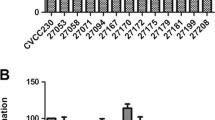Abstract
The present investigation was conducted to assess lactic acid bacteria present in traditionally fermented food of ethnic tribes in India for probiotic properties, antibacterial activity, and antibiotic tolerance behavior. Enterococcus sp., Lactobacillus sp., and Lactococcus sp. showed antibacterial activity against Bacillus cereus MTCC 430, Staphylococcus aureus subsp. aureus MTCC 740, and Salmonella enterica ser. paratyphi A MTCC 735. Lactococcus sp. and Lactobacillus sp. could tolerate acidic conditions (pH 2) and high bile salt concentration (4000 ppm). The lactic microflora were found to be sensitive to most common antibiotics, except for cloxacillin (5 μg), cephalexin (30 μg), and cephalothin (30 μg).
Similar content being viewed by others
References
Ampe, F., Omar, N.B., Moizan, C., Wacher, C., and Guyot, J.P. 1999. Polyphasic study of the spatial distribution of microorganisms in Mexican Pozol, a fermented maize dough, demonstrates the need for cultivation-independent methods to investigate traditional fermentations. Appl. Environ. Microbiol. 65, 5464–5473.
Arihara, K., Ota, H., Itoh, M., Kondo, Y., Sameshima, T., Yamanaka, H., Akimoto, M., Kanai, S., and Miki, T. 1998. Lactobacillus acidophilus group lactic acid bacteria applied to meat fermentation. J. Food Sci. 63, 544–547.
Batish, V.K. and Ranganathan, B. 1986. Antibiotic susceptibility of deoxyribonuclease positive enterococci isolated from milk and milk products and their epidemiological significance. Int. J. Food Microbiol. 16, 203–206.
Bauer, A.W., Kirby, W.M.M., Sherris, J.C., and Turck, M. 1966. Antibiotic susceptibility testing by a standardized single disk method. Am. J. Clin. Pathol. 45, 493–496.
Davies, R. and Roberts, T.A. 1999. Antimicrobial susceptibility of enterococci recovered from commercial swine carcasses: effect of feed additives. Lett. Appl. Microbiol. 29, 327–333.
Erkkila, S. and Petaja, E. 2000. Screening of commercial meat starter cultures at low pH in the presence of bile salts for potential probiotic use. J. Meat Sci. 55, 297–300.
Franz, C.M., Muscholl-Silberhorn, A.B., Yousif, N.M.K., Vancanneyt, M., Swings, J., and Holzapfel, W.H. 2001. Incidence of virulence factors and antibiotic resistance among Enterococci isolated from food. Appl. Environ. Microbiol. 67, 4385–4389.
Gilliland, S., Staley, T., and Bush, L. 1984. Importance of bile tolerance of Lactobacillus acidophilus used as dietary adjunct. J. Dairy Sci. 67, 3045–3051.
Giraffa, G. 2002. Enterococci from foods. FEMS Microbiol. Rev. 26, 163–171.
Goldin, B. and Gorbach, S. 1992. Probiotics for humans, pp. 355–376. In Fuller, R. (ed.), Probiotics-the scientific basis, Chapman and Hall, London, UK.
Gonzalez, C.F. and Kunka, B.S. 1987. Plasmid-associated bacteriocin production and sucrose fermentation in Pediococcus acidilactici. Appl. Environ. Microbiol. 53, 2534–2538.
Holt, J.G., Krieg, N.R., Sneath, P.H.A., Staley, J.T., and Williams, S.T. 2000. Bergey’s Manual of Determinative Bacteriology. 9th edition, Lippincott Williams & Wilkins, USA.
Jeyaram, K., Mohendro, S.W., Premarani, T., Ranjita, D.A., Selina, C.K., Talukdar, N.C., and Rohinikumar, S.M. 2008. Molecular identification of dominant microflora associated with ‘Hawaijar’ — A traditional fermented soybean (Glycine max (L.)) food of Manipur, India. Int. J. Food. Microbiol. 122, 259–268.
Klaenhammer, T., Altermann, E., Arigoni, F., Bolotin, A., Breidt, F., Broadbent, J., Cano, R., Chaillou, S., Deutscher, J., Gasson, M., and et al. 2002. Discovering lactic acid bacteria by genomics. Antonie van Leeuwenhoek 82, 29–58.
Klein, G., Pack, A., and Reuter, G. 1998. Antibiotic resistance patterns of enterococci and occurrence of vancomycin-resistant enterococci in raw minced beef and pork in Germany. Appl. Environ. Microbiol. 64, 1825–1830.
Lim, S.M. and Im, D.S. 2009. Screening and characterization of probiotic lactic acid bacteria isolated from Korean fermented foods. J. Microbiol. Biotechnol. 19, 178–186.
Paludan-Muller, C., Huss, H.H., and Gram, L. 1999. Characterization of lactic acid bacteria isolated from a Thai low-salt fermented fish product and the role of garlic as substrate for fermentation. Int. J. Food Microbiol. 46, 219–229.
Pennacchia, C., Ercolini, D., Blaiotta, G., Pepe, O., Mauriello, F., and Villani, F. 2004. Selection of Lactobacillus strains from fermented sausages for their potential use as probiotics. J. Meat Sci. 67, 309–317.
Robrido, B., Singh, K.V., Baquero, F., Murray, B.E., and Torres, C. 2000. Vancomycin-resistant enterococci isolated from animals and food. Int. J. Food Microbiol. 54, 197–204.
Singh, N.I. and Umabati, D.A. 1995. Fermentation prospects of two phylloplane bacteria in traditional Hawaijar made from boiled soybean (Glycine max L.). J. Food Sci. Technol. 32, 219–220.
Sohliya, I., Joshi, S.R., Bhagobaty, R.K., and Kumar, R. 2009. Tungrymbai-traditional fermented soybean food of the ethnic tribes of Meghalaya. Ind. J. Trad. Knowle. 8, 559–561.
Tamang, J.P. 2003. Native microorganisms in the fermentation of Kinema. Int. J. Food Microbiol. 43, 127–130.
Teuber, M. and Perreten, V. 2000. Role of milk and meat products as vehicles for antibiotic-resistant bacteria. Acta Vet. Scand. 93, 75–87.
Vlková, E., Rada, V., Popelářová, P., Trojanová, I., and Killer, J. 2006. Antimicrobial susceptibility of bifidobacteria isolated from gastrointestinal tract of calves. Livestock Sci. 105, 253–259.
Yang, R., Chen, Y., and Ray, B. 1999. Enhanced bacteriocin production by lactic acid bacteria in a diary based medium, supplemented with β-galactosidase. Ind. J. Microbiol. 39, 235–240.
Zamudio-Maya, M., Narva ez-Zapata, J., and Rojas-Herrera, R. 2008. Isolation and identification of lactic acid bacteria from sediments of a coastal marsh using a differential selective medium. Lett. Appl. Microbiol. 46, 402–407.
Author information
Authors and Affiliations
Corresponding author
Rights and permissions
About this article
Cite this article
Thokchom, S., Joshi, S.R. Antibiotic resistance and probiotic properties of dominant lactic microflora from Tungrymbai, an ethnic fermented soybean food of India. J Microbiol. 50, 535–539 (2012). https://doi.org/10.1007/s12275-012-1409-x
Received:
Accepted:
Published:
Issue Date:
DOI: https://doi.org/10.1007/s12275-012-1409-x




